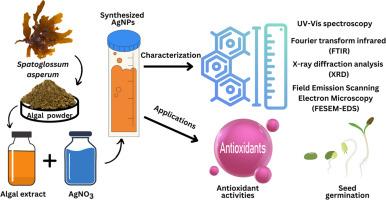由海洋藻类 Spatoglossum asperum 合成的银纳米粒子:抗氧化性和种子发芽率的提高
IF 5.4
Q2 ENGINEERING, ENVIRONMENTAL
引用次数: 0
摘要
生物合成的银纳米粒子(AgNPs)在压力条件下的植物生长中显示出了巨大的潜力,但海洋藻类合成的 AgNPs 仍然是探索最少的。本研究以海洋褐藻 Spatoglossum asperum 的水提取物为还原介质,合成了 AgNPs,并研究了其在盐胁迫条件下对 Vigna radiata 种子生长的应用。此外,还评估了 AgNPs 与海藻提取物相比的抗氧化潜力。利用海藻提取物合成的 AgNPs 通过紫外-可见光谱、傅立叶变换红外光谱、X 射线衍射分析、场发射扫描电子显微镜(FE-SEM)和能量色散 X 射线光谱(EDS)进行了表征。场发射扫描电子显微镜(FE-SEM)和能量色散 X 射线光谱(EDS)的结果证实了多形状(球形、立方体和纳米簇)颗粒的形成,平均粒径为 43.65 nm。研制出的 AgNPs 在 425 nm 处显示出表面等离子体共振带,并呈现出面心立方晶体结构,平均晶粒大小为 23.05 nm。傅立叶变换红外光谱确保了二硫化物和多硫化物参与了纳米粒子的合成。研究结果表明,藻类合成的 AgNPs 与单独的藻类提取物相比,具有更强的抗氧化活性,并能在正常和盐碱条件下显著提高黑木耳的种子萌发率。这些研究结果表明,从 Spatoglossum asperum 中提取的 AgNPs 可在农业和环境可持续发展方面发挥关键作用。本文章由计算机程序翻译,如有差异,请以英文原文为准。

Silver nanoparticles synthesized from marine algae Spatoglossum asperum: Antioxidant properties and seed germination enhancement
Biosynthesized silver nanoparticles (AgNPs) have shown promising potential in plant growth under stressed conditions but marine algae synthesized AgNPs still remain least explored. In the current study, AgNPs have been synthesis by using the aqueous extract of marine brown alga Spatoglossum asperum as a reducing medium and their application in the growth of Vigna radiata seeds under salt stress conditions was studied. The antioxidant potential of AgNPs in comparison with algal extract was also assessed. The AgNPs synthesized using the algal extract was characterized by means of UV–Vis spectroscopy, Fourier transform infrared (FTIR) spectroscopy, X-ray (XRD) diffraction analysis, Field emission scanning electron microscopy (FE-SEM) and Energy dispersive X-ray spectroscopy (EDS). The FE-SEM and EDS results confirmed the formation of multi-shaped (spherical, cubical and nano-clusters) particles with average size of 43.65 nm. Developed AgNPs showed a surface plasmon resonance band at 425 nm and a face-centric cubic crystallographic structure with an average crystallite size of 23.05 nm. The FTIR spectrum ensured the involvement of di and polysulphides in the synthesis of nanoparticles. The results revealed that the algal synthesized AgNPs showed superior antioxidant activity compared to the algal extract alone and significantly enhanced seed germination in Vigna radiata under both normal and saline conditions. These findings suggest that Spatoglossum asperum derived AgNPs could play a pivotal role in agriculture and environmental sustainability.
求助全文
通过发布文献求助,成功后即可免费获取论文全文。
去求助
来源期刊

Journal of hazardous materials advances
Environmental Engineering
CiteScore
4.80
自引率
0.00%
发文量
0
审稿时长
50 days
 求助内容:
求助内容: 应助结果提醒方式:
应助结果提醒方式:


